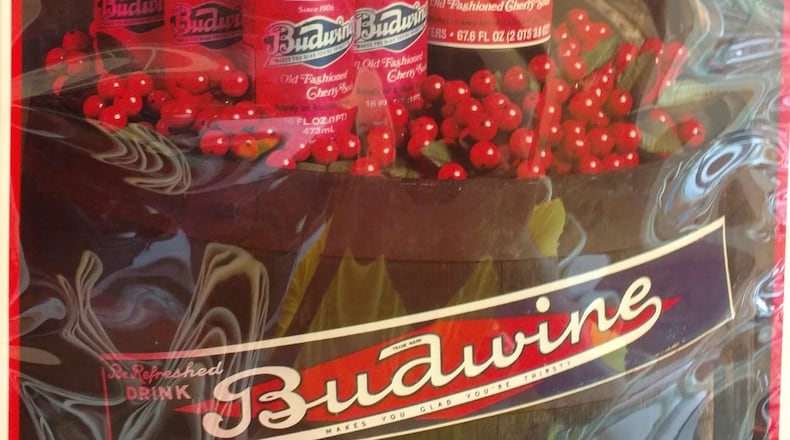What is it about the South and our soft drinks? As anyone who’s ever witnessed a Coke vs. Pepsi discussion can attest, Southerners are known to exhibit the ultimate brand loyalty for those carbonated drinks that first emerged from this region back around the turn of the 20th century as the temperance movement was sweeping the nation.
But the battle between Coke and Pepsi, born respectively in Georgia and North Carolina, isn't the only soda pop smackdown involving those two states over the decades, as I was reminded recently by a news report about longtime Carolina favorite Cheerwine teaming up with Krispy Kreme for a special promotion.
Cheerwine, mainly drunk in the Carolinas and Virginia — but available in some Atlanta groceries — is a cherry-flavored drink that once was the wannabe nipping at the heels of a cherry soda based in my own Georgia hometown of Athens: Budwine.
Cheerwine is OK, but whenever it’s mentioned, anyone who ever drank its more cherry-tasting Athens rival tends to shake their head wistfully and say, “You should have tasted Budwine.”
Unfortunately, Budwine is no longer around, but there was a time, back before World War I, when the bubbly red drink was being turned out in more than 100 bottling plants, ranging from Georgia to California.
Budwine was created back in 1906 by an Athens teetotaler named H.C. Anderson, who wanted to create a drink that would lure people away from alcohol. So he and a chemist from Elberton blended 18 or so fruit flavors with a cherry base and ginger, and the concoction, originally dubbed “Bludwine,” was an immediate success.
Cheerwine, meanwhile, didn't come along over in Salisbury, N.C., until 1917, and was largely confined to a corner of that state for much of its early life. Athens legend has it that a former Bludwine bottler just tweaked the formula for that drink to come up with Cheerwine, but that's, of course, not the story they tell in the Tar Heel state.
The popularity of Bludwine, billed on its distinctive hobble-skirt bottles as “The Food Drink” and “For Your Health’s Sake,” continued to grow until 1921, when the federal government, concerned that doctors were actually prescribing it as a blood tonic, made the company take the letter “L” out of the name and call it “Budwine.”
The cost of retooling for the name change started a long decline for the drink, and by the time a guy named Joe Costa, of a famed Athens ice cream parlor family, bought it in 1930, it had declined to about 25 bottlers, mostly in the Southeast.
Along with the Budwine formula and trademark, Costa got an absolutely terrific marketing slogan, “Makes You Glad You’re Thirsty.” However, the one that got away was “Good to the Last Drop,” which the Budwine Co. had used briefly but didn’t register, much to the delight of Maxwell House Coffee.
Then came the Depression, and Costa put Budwine on the back burner while he concentrated on a cheaper brand that sold for 2 cents less than the normal nickel soft drink: Three-Centa. The drinks sold well, though my Dad, who grew up in the Athens area, once recalled, “If a fella was real cheap, they’d say that on a date he’d buy a Three-Centa and two straws.”
World War II ended the Depression and the need for Three-Centa. Budwine survived, but the number of plants dwindled to just those in Augusta and Athens, which Costa sold off in the early 1950s. He still owned the formula to Budwine, which the Athens Pepsi-Cola plant distributed in a 15-county area.
The drink reached a low point in 1969, when the Pepsi plant was sold and the new owners dropped all non-Pepsi products. For a while, it was available only at the Dairy Queen in Athens (where a “secret menu” offering was to get them to mix you up a Budwine milkshake!).
Then, about the time I graduated from the University of Georgia in 1974, my old schoolmate Butch Costa took over the brand from his dad with a former fraternity brother as his partner.
The “old fashioned cherry soda,” as it was billed on the new packaging, remained a local favorite in Northeast Georgia on through the 1980s with an ad hoc lineup of bottlers that included the Athens Coke company.
Eventually, the younger Costa (who now goes by Joe like his dad) and his partner sold Budwine to its Augusta area bottler, who continued producing the drink for a few years until deciding to focus instead on bottled water. Sometime in the 1990s, Budwine disappeared from stores.
So, one recent Saturday morning, I asked Joe, who’s now in the insurance business in Athens, about what happened to Budwine. He said the bottler who bought the trademark and formula eventually sold it to Anheuser-Busch, which had been wanting for years to get the drink off the market because of their aversion to any other product that had “Bud” in its name.
“They were just after the name,” Costa said. “They shut it down.”
Still, the Budwine legend lives on, especially in Costa’s home, where he still has old glass Budwine bottles and latter-day marketing materials, and where a reproduction of a Norman Rockwell painting — showing a freckle-faced boy in knee pants and beanie slurping a bottle of Budwine as his thirsty mongrel puppy looks on — hangs on the wall.
The original pre-1921 commercial Rockwell painting, called “Budwine Boy and Dog,” was auctioned off years ago, Costa said, and he believes it’s somewhere in South America.
Budwine drinkers still lament the passing of their favorite cherry drink, however. There are Facebook groups devoted to it, and Joe said he still has people telling him they wish they could get it.
“I tell them, go get a Cheerwine,” he said. “That’s as close as you’re gonna get.”
Maybe so, but it’s just not the same.
About the Author
The Latest
Featured


